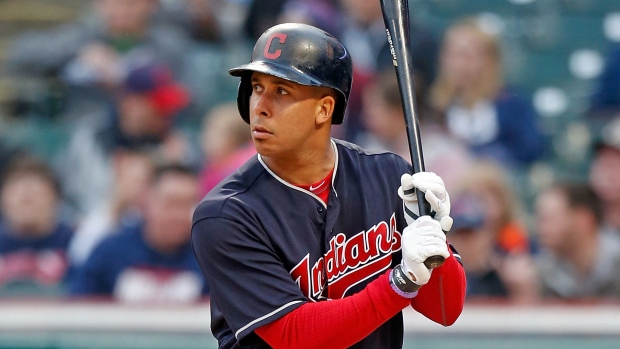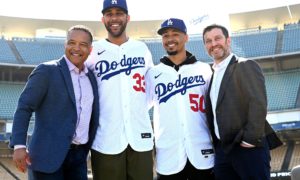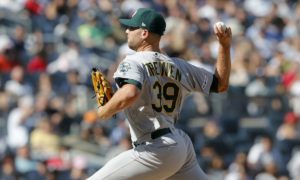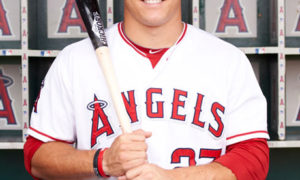Could Hitters Who Strike Out Less Go Up in Value?


Since signing his seven-year/$161 million
Is Chris Davis beyond redemption? It’s tough to say without studying film of him more closely—not that one would probably relish watching it or know what to look for. If you’re an Orioles fan or part of their managerial staff, you’re praying he isn’t. Especially not at over $20 million a year for another four years.
Whatever Davis’s future holds, his struggles are a cautionary tale for teams who pin their hopes on a “three true outcomes” slugger. Davis is also a case study in what extreme defensive shifting can do to a player that can’t or won’t adapt. Davis was one of the most-shifted-against batters in baseball in 2018. Of course, shifts don’t matter when you hit a home run and that’s what Davis gets paid to do. When he doesn’t, though? The results can be pretty darn hard to watch. Cue myriad shots of Davis et al. grounding out to the second baseman lined up in the outfield grass. It’s why Major League Baseball has toyed with the idea of banning (at least partially) defensive shifts. If you feel like the Royals’ Ned Yost, you’re likely all for it. If you’re of a similar mind to the Brewers’ Craig Counsell? Whoa, back it up.
This is an easy subject about which to wax philosophical from one’s armchair or makeshift dugout. When it comes to trying to hit major-league pitching, all bets, as they say, might be off. In a June article for ESPN, Jerry Crasnick addressed the prevailing thought of “Why
Daniel Murphy discussed his approach and how he tries to hit fly balls and line drives rather than ground balls. He thinks that if only a small portion of ground balls go for extra bases, it’s not worth trying to hit them. Odds are he will only score from first with two more hits unless he steals second, and he hasn’t had more than 10 steals in a season since 2014. As he explains, if he could control where his hits go, he would. But you can’t. You can only control the swing process, not the results.
Kyle Seager and Matt Carpenter echo Murphy’s sentiments. As Seager reasons, he’s most useful when he gets extra-base hits because it takes fewer hits to get him in. Like Murphy, he’s no prolific base-stealer. Besides, if he bunts, there’s a good chance he’s doing what the opposition wants. After all, he’s not beating them with a home run. As for Carpenter, he adds that hitting 95+ MPH exactly where you want, um, is hard.
For several reasons, trying to hit to beat the shift can blow up in your face. Heck, even trying to bunt when you aren’t used to doing it can result in broken bones. Just ask Matt Adams.
Murphy’s, Seager’s, and Carpenter’s comments are a direct rebuttal to the logic of “go the other way.” In Murphy’s words, that would require “perfect” execution and players aren’t perfect.
Carpenter, for one, wouldn’t mind seeing the league
Are batters really at an unfair disadvantage when they step to the plate? If so, what can teams do to narrow the gap?
On the first count, it’s a matter of debate. Certainly, that Major League Baseball would discuss banning shifts suggests that some folks believe it to be the case. Sure, there might be a bit of a fundamentalist component to advocates for restricting defensive shifting. ‘Why, in my day, we didn’t have all these shifts and baseball was just fine!’ This is before we even get to how effective shifts are overall. As research
To Carpenter’s second point about narrowing a perceived gap, teams are already implementing creative approaches to training their hitters. Alden Gonzalez, also writing for ESPN, delves into the world of combatting ever-increasing velocity, spin rate, and yes, defensive shifts. Gonzalez cites Andrew Friedman, LA Dodgers president of baseball operations, in the belief that run prevention advancements “have dwarfed what’s going on in the run-scoring side.”
However, that may be changing. Both the Dodgers and the LA Angels are employing multiple hitting coaches on their staffs this upcoming season. They’re not necessarily ex-players with storied careers either. One specialist interviewed for the piece, Robert Van Scoyoc, was admittedly a “very mediocre” player in high school and college. Yet as a hitting consultant, he has helped players like J.D. Martinez and Chris Taylor flourish.
Jason Ochart, director of hitting at Driveline Baseball, thinks yet more innovation can and should be implemented. Possible interventions include replacing traditional batting practice with high-velocity pitching machines, cross-referencing hitter heat maps
It’s Ochart’s thoughts on which type of players may thrive in this changing environment, however, that are most intriguing. The pendulum has swung more recently toward hitters who sell out after two strikes and lift the ball without fail. But it may be swinging back to players who don’t strike out as much and who make shifting problematic. Ochart’s cited example is Michael Brantley, who recently got picked up by the Houston Astros for two years/$32 million.
Could Ochart be right? Could a sea change be underway that prizes players with a two-strike approach? I hope so. Some of the best moments in baseball are when a pitcher and hitter go at it for pitch after pitch. Who will blink first? Will the runner on first try to steal second and throw a wrench into the whole affair? It’s a chess match, replete with mound visits and suspicions of sign-stealing. That, to me, is exciting. It is even important from a tactical standpoint; more pitches thrown increases the likelihood of fatigue or an early exit from a pitcher.
So who has the best approach in this new world? It seems that players who walk more than they strikeout would be useful. Among qualified hitters in 2018, 27 players finished with a BB/K rate of 0.65 or better. Speaking of Brantley, he finished just outside the top 10 at 0.80. Carlos Santana (1.18), a recent re-acquisition by Cleveland, was bested only by Jose Ramirez (1.33). Andrew McCutchen (0.66), now a member of the Phillies, was top-25.
Even Matt Carpenter, our opinionated anti-shifter from earlier, sneaks in at 0.65. If they weren’t already so sought after, Bryce Harper (0.77) and Manny Machado (0.67) might be more notable for their inclusion on this list. In all, players who make contact or are walked to avoid it are indeed valuable. Andrelton Simmons. Ben Zobrist. Joey Votto. Nick Markakis. These guys can contribute, especially against tough pitching.
At the same time, though the pendulum may swing, there will always be teams willing to pay for power. As the saying goes, chicks dig the long ball. The Home Run Derby is still a yearly tradition. Dingers will continue to predominate in SportsCenter highlights, as dunks do for NBA recaps. Even with sluggers more liberally positioned around the diamond, home run hitters will yet draw attention and excitement.
But these efforts to combat shifts and flame-throwing hurlers are encouraging for making baseball a better product to watch. It also should give stats nerds more to analyze and debate, increasing their enjoyment to boot.
Accordingly, I tend to side more with Camp Craig Counsell than I do the Yost faction of Major League Baseball. Beating the shift isn’t as easy as some of us might think. With advances in technology and training, the times are changing and the gap between pitchers and hitters might narrow more quickly than it expanded. Let’s see if more teams follow the lead of the Angels and Dodgers before we start over-legislating the game.
-Joe Mangano




















